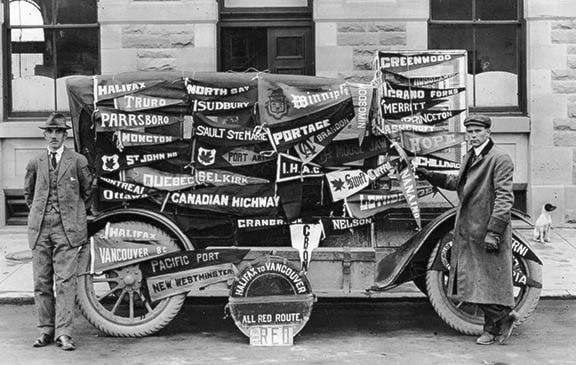Jim Cameron
Okay, let's get a few things straight right from the outset. When we speak of "The Great Divide" we are not talking about anyone dying. We are speaking of the geological — or more precisely, hydrological — Continental divide, which separates the waters that flow to the Pacific from those of the Atlantic. It runs from the top of Alaska to the bottom of South America, and is the title of numerous songs, a band or two, some movies and books and a micro-brewery in Denver, Colorado — but that is of little interest here. The fact that it separates B.C. from Alberta is.
Further, when we speak of "Wilby at the Wheel," he wasn't. Oh, he was in the car, all right, but he wasn't driving. Fonce "Jack" Haney was driving and by the time the trip was over they weren't speaking to one another. Long trips can do that and this was a very long trip.
Later, when Thomas W. Wilby wrote a book about the adventure he conveniently neglected to mention Mr. Haney at all. Thus, Wilby is generally known as the man of the hour and Haney the other guy. The book "A Motor Trip through Canada" chronicles the 52-day trip from Halifax to Port Alberni on Vancouver Island in 1912 — the first Trans-Canada automobile trip — and the road passed through Cranbrook.
Travelling across Canada by car in 1912 was no mean feat. The journey traversed the "All Red Route", the all-Canadian, occasionally non-existent, southern road-way system marked on maps with the traditional cartographer's red of Great Britain and was sponsored by Ransom E. Olds, former developer of the Oldsmobile and, at the time, owner of the REO Motor Car Co., with factories in Lansing, Michigan, and St. Catherine's, Ontario. Messrs Wilby — an older English writer — and Haney — a young American mechanic — travelled in a new REO five-seat touring sedan. It was representative of the best an auto could offer in the day: A four-cylinder, 35 horsepower engine that could reach a top speed of 38 mph (60 km), a hand-crank starter with an interior spark switch to stop the engine, a three-speed and reverse gear shift in the centre (a new feature), leather seats, acetylene headlights with kerosene side and rear lamps, 34-inch wooden spoke wheels, two rear wheel brakes and a 14-gallon gasoline tank. The car retailed at $1,500 Canadian. Another $100 added the accessories: a top, a top cover, curtains, a windshield and a speedometer. Always nice to have the extras.
The REO crossed the Continental Divide on Oct. 3, reaching Michel at noon and arriving at the Fort Steele/Wardner junction near dusk, where it was met by four vehicles carrying Cranbrook dignitaries, newspapermen and auto enthusiasts.
The travellers stayed overnight at the Cranbrook Hotel and attended a ceremony in front of City Hall at noon the next day. Mr. DeVere Hunt — speaking on behalf of Mayor Bowness who was suffering from a sore throat — called it a “red-letter day” for Cranbrook. Mr. Wilby, in reply, stated he could not say much as his heart was full of the splendid reception he had received since entering B.C., especially in Cranbrook. Shortly thereafter the REO left town amidst cheers from the large crowd, headed for Yahk, and on to the Pacific.
Mr. Wilby speaks of Cranbrook in his book published in 1914: “Superb trails and roads led into the town, the pilot car dashing off at a clip which would have brought disaster on anything but a first-class surface. The town itself received us with open-handed hospitality. Cranbrookites are never tired of telling strangers of the wonderful valley which will soon be open to motor tourists by the construction of a scenic road from Cranbrook to Banff. Cranbrook was interesting but at first sight there was not much to see. It seemed to be about the size of a man’s pocket-handkerchief, a mere village in dimensions. A hotel ... a railroad station, a modest town hall, a few more or less sleepy stores, a formless back street or two, a chaotic pavement and a YMCA building ... that was all.
“But Cranbrook had hidden riches. Like many another town of the West, it had men who had interpreted education in the terms of opportunity and progress and communal welfare, who were using it as an instrument which would solve for them the problem of a social life free from the trammels of tradition. It had no wastrels, no drones, no men of leisure. No one was hurrying, but neither was any one wasting strength or capital, foresight or initiative. Cranbrook is the home of the self-made man. Culture and refinement are not ordinarily the weapons with which Nature hews out the wilderness.”
Ouch! Though often marvelling at the scenery throughout the journey, the author’s humour betrays a certain arrogance concerning the people and places along the route. Undoubtedly many who cheered him on only to later read of themselves and their town cast in the author’s condescending light might have preferred that Mr. Wilby, when he reached the Pacific Ocean in October, 1912, continued driving.
As for crossing the Great Divide, Messrs Wilby and Haney were not the first. The first recorded automobile to travel the Crows Nest Pass (the first pass in the Rockies capable of being traversed by an automobile) occurred in September, 1910, when Cranbrook resident Dr. F.W. Green and companions, Messrs Beattie, Staples and Supple, travelled to Coleman and points east.
For an entertaining look at the relationship between Wilby and Haney, see “Kootenay Tales — Historical Glimpses of the Past” published in 2008 by local author Arlene Pervin.
